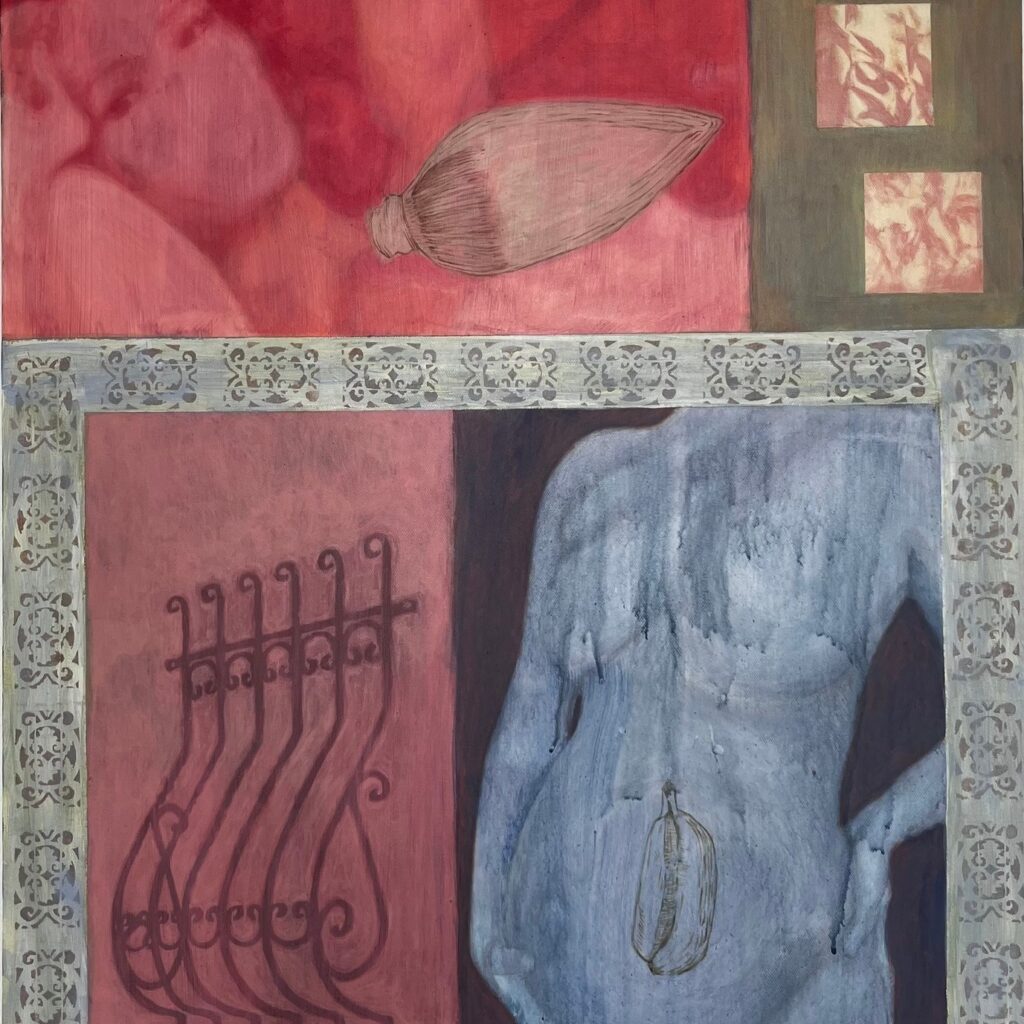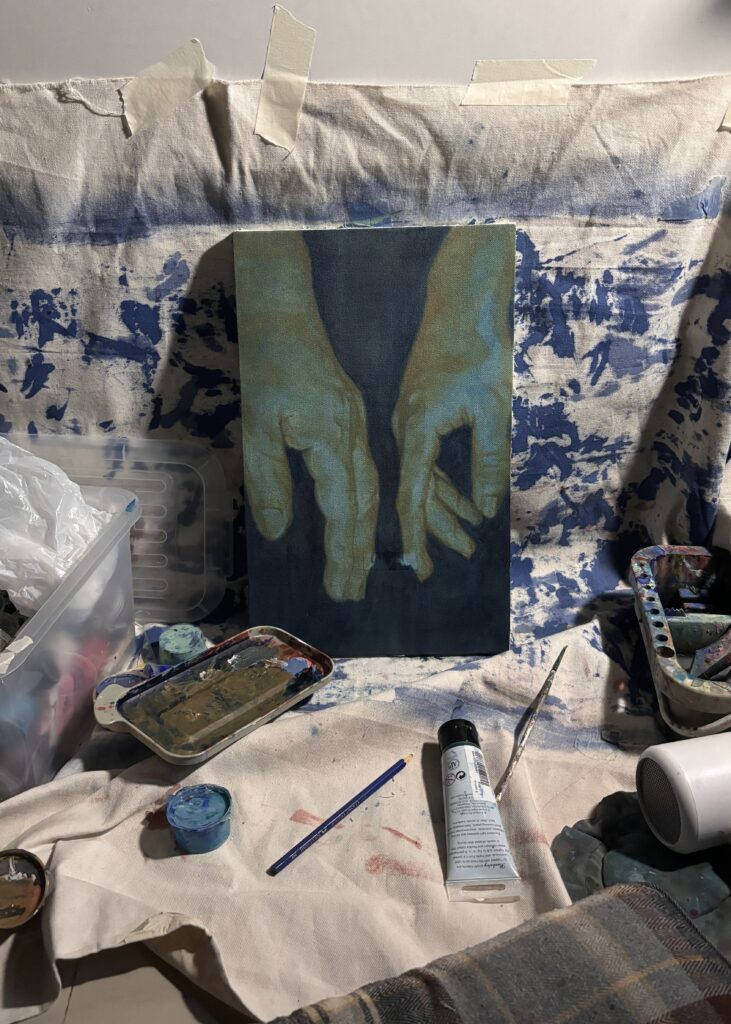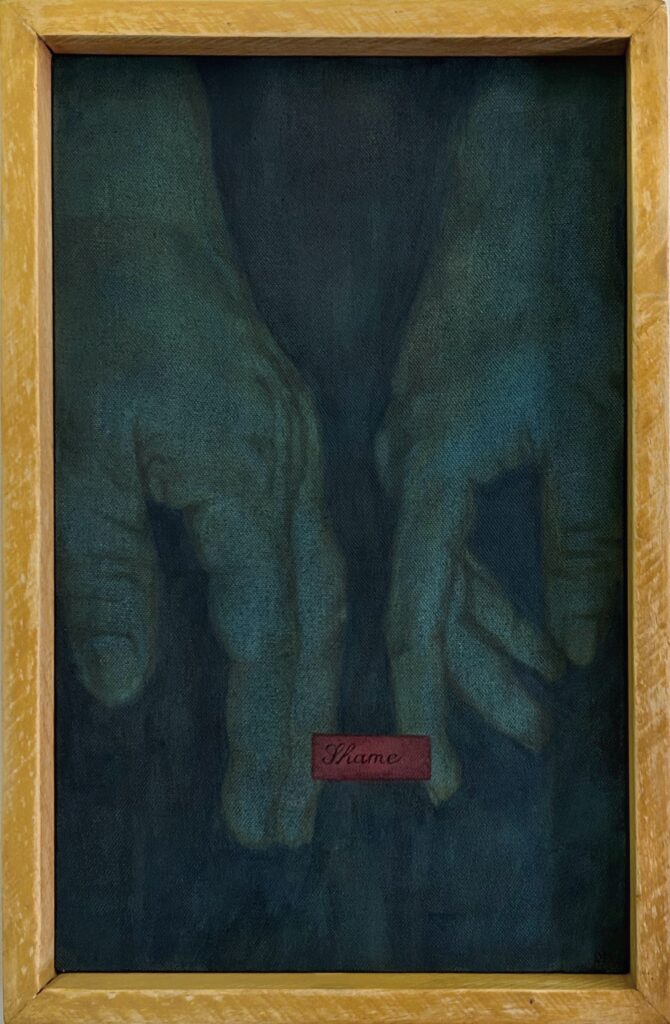Deya Java’s art practice encompasses a variety of media—installation, printmaking, assemblage, and painting—exploring themes of personal and collective memory, history, spirituality, and postcoloniality. Her works delve into the nature of images and symbols to explore alternative possibilities of perceiving her own environment, both within and beyond its immediate boundaries.
Fascinated with the process of transforming the commonplace and the unfamiliar, her assemblages frequently incorporate found objects to explore narratives in which these objects come into being and the ways in which they can be re-appropriated in another context.
Much of her recent work centers on the female body and engages with the queer gaze, reflecting on systemic social values within her culture and the ways in which they are inscribed onto bodies, spaces, and memories.

Where the heart is, 2024, acrylic on canvas, 91.44 cm x 60.96 cm
The intention behind Where the Heart Is is to explore the interplay of personal memories and cultural symbols. This work reflects on the pamahiin (superstitions) I grew up hearing, particularly those surrounding bananas—an object I believe is rich in metaphorical meaning.
One of the superstitions depicted in the artwork is the belief in kapid nga saging (twin bananas), where old folks would say that if a woman consumes one, she will give birth to twins. Additionally, the word puso in puso ng saging (banana blossom) is the same word for “heart” in Tagalog, a connection that briefly intrigued me in childhood.More recently, during a visit to historical churches and homes, I encountered decorative grillwork commonly found in traditional Filipino architecture. I was particularly struck by how its form resembled a womb and how it was designed that way to hold plants—a nurturing space for life and growth.
In this work, I wove these visual references—bananas, architectural details, and elements from Spanish colonial churches and traditional Filipino homes—to reinterpret nostalgia and find connections between these seemingly unrelated images in hopes of forming a new narrative.
I arranged the visual references in a collage format, each within its own frame, existing in its own world. Yet, there remains a sense of fluidity, as these images are inherently interconnected. By bringing together images I encountered at different times and places, new narratives emerge—effectively “re-membering” them, both in memory and as a way of reconstructing meaning. This was my intention for the work: to explore the relational potential of images and how their connections create new interpretations.
What I liked most about this artwork was the process of making it.Revisiting childhood memories and photos from the trip allowed me to explore connections between them, which made the process exciting. I enjoyed experimenting with a new composition for a visual narrative, combining different imagery in ways I hadn’t done before. It was fulfilling to see ideas flow and come together in an unexpected yet meaningful way.

Before I go on with my day, I make sure to drink my coffee as it gets me prepared for the whole day. I usually work on a painting and other tasks later in the day when my mind is more active. When working on an artwork, especially with a given theme or prompt, Istart by creating an image bank and I collect as many visual references as possible. Once I feel satisfied with the references, I begin sketching and making studies to develop my ideas.

Shame, 2024, acrylic on canvas, 30.48 cm × 20.32 cm
In this work, I wanted to explore the concept of shame in relation to queerness, and this piece serves as my first painting study on the subject. Shame, especially in queer experiences, often manifests in subtle, everyday moments—hesitations, silences, or the need to regulate one’s own actions in public. I wanted to capture that tension and vulnerability, revealing how social norms shape the way queer individuals navigate intimacy and visibility.
I recalled stories from friends and personal experiences of being queer, particularly the moments of having to avoid showing affection in public. With that in mind, I decided on a close-up painting of two hands—an image that carries both intimacy and restraint. The focus on hands allows for an exploration of touch, longing, and hesitation.
About the artist
Judhea Java, aka Deya (b. 2001), is a multidisciplinary artist based in Cebu, Philippines. She is currently pursuing a Bachelor of Fine Arts degree with a major in Studio Arts at the University of the Philippines, Cebu. In 2023, she was awarded first place in the Oil/Acrylic Category at the 56th Shell National Student Art Competition (NSAC), the Philippines’ longest-running student art competition, for her work ‘Weaving the Narrative, which paid homage to women artisans across the country. Deya has participated in a number of exhibitions in Iloilo, Cebu, and Manila, including: Doble Kahit (2019), Come Together (2019), Finding Home (2021), Dessert (2022), Pressing Perspectives (2024), A Room of Her Own (2024), and Tayog-tayog (2024).
